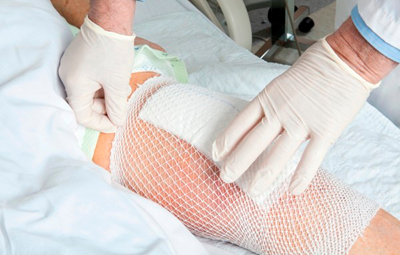More than 200 million people experience severe forms of incontinence,1 yet its effect on skin integrity is not well identified. In my own practice, I provide care to patients in acute care facilities, long term care settings, home health care and outpatient settings. I find approximately 45 percent of incontinence associated dermatitis (IAD) presentations are mislabeled as stage 2 pressure injuries. What does that mean? Healthcare providers need additional education on identification, prevention and treatment of this condition.
“We’re not doing a good enough job.”

Catherine Milne
MSN, APRN, ANP/ACNS-BC, CWOCN-AP, Medline consultant
How to identify signs of IAD and why it matters
IAD is a subset of the overall clinical phenomenon called moisture-associated skin damage (MASD). It is associated with urinary incontinence or fecal incontinence or both.
IAD is characterized by:
- Erythema
- Edema of the surface of the skin
Sometimes accompanied by:
- Serous exudate
- Erosion
- Secondary cutaneous infection.2
Without proper identification and prevention of incontinence associated dermatitis, patients are at higher risk for skin breakdown and pressure injuries, particularly in the buttocks area.
Mistaking IAD for pressure injuries can not only harm your patients, it affects your facility’s quality measures. Knowing incontinence associated dermatitis contributes to the development and deterioration of pressure injuries, it is often a major factor in pressure injury reportable events. In other words, any mislabeled data submitted to regulatory agencies is interpreted at face value, falsely impacting pressure injury rates—if the IAD is reported as a pressure injury instead. This, in turn, negatively impacts your Nursing Home Compare and Home Health Compare scores, and is a focus area at survey time.
Who’s at risk for urinary and fecal incontinence
- Older patient population
- Patients who have undergone radiation or chemotherapy
- Patients on medication that may have a side effect of incontinence
- Patients who have undergone bowel surgery
- Patients with dementia
- Patients with diabetes who may be experiencing urinary retention with overflow or have had recent catheter removal
Why is IAD a safety issue?
If you think about framing IAD as a safety issue, it helps elevate prevention to top priority, equal with other safety initiatives. It starts with your patients, which is difficult, as talking about incontinence is still awkward for so many people. Consider the ads for incontinence briefs: They don’t even speak directly to the
problem. They say things like, “Do you have a going problem?” What if these ads presented the problem head-on, asking, “Are you leaking urine?”
Even among healthcare professionals, it’s a touchy subject. We often do not ask the right questions and, once incontinence is identified, we undervalue the importance of starting a comprehensive incontinence management program.
Physiologically, prevention is key because skin damage starts before you can see anything. Disruption to the skin barrier with incontinence increases transepidermal water loss (TEWL), which triggers the skin’s inflammatory response. Even before you “see red,” there is skin injury.
Questions to ask yourself about a patient with IAD
- What is the underlying reason for the incontinence?
- Can the patient be continent with some interventions?
- Is there another physiological issue that’s making the patient incontinent?
- Is the patient simply scared he or she will fall and therefore not attempting a trip to the bathroom?
- Does the patient have the right equipment to make them feel confident using the toilet at home?
How to help treat incontinence associated dermatitis
Anybody that is incontinent should have prevention in place. When you see redness, the opportunity for true prevention has been lost. Once that happens and you suspect IAD, there are steps you should take:
- Enlist a knowledgeable colleague. Get help to determine what is causing the incontinence and protect the skin from further breakdown with the resources you have. This might include an external female collection device or condom catheter, and the use of a body-worn absorbent product such as a brief, if clinically indicated.
- Treat the issue. Treatment to the skin should include pH-balanced cleansers and moisturizers and skin protection. We now have newer skin protection options available as alternative to pastes: cyanoacrylate liquid skin protectants. The cyanoacrylate meets the needs of the patient and the nurse as application takes a short time, can be less uncomfortable than other options, and resists prolonged exposure to urine.3
- Educate the patient. If this is a patient who will be discharged and caring for themselves at home, talk to them about which type of protective underwear, pad or incontinence brief to choose, as well as the importance of the right cleansing routine as they return to their own optimal continence ability. There are many resources available from professional organizations.
Tools to help reduce IAD at your facility
- Effective use of resources such as occupational and physical therapists who can improve mobility and make environmental modifications. Some have incontinence training background.
- Appropriate assessment, selection and use of absorbent products
- Individualized incontinence care
- The right skin care routine
- Staffing levels and workflows to allow for continence care
Key takeaway
In the end, care providers need to get over the stigma of incontinence. Don’t assume it can’t be treated. Emphasizing its importance in the pressure injury continuum can help prevent more serious skin breakdown. Learn more about how to encourage skin health knowledge and understanding among your staff.
References:
- Beguin, AM., Malaquin-Pavan, E., Guihaire, C. et al. Improving diaper design to address incontinence associated dermatitis. BMC Geriatr 10, 86 (2010). https://doi.org/10.1186/1471-2318-10-86
- Gray, M., & Giuliano, K. K. (2018). Incontinence-Associated Dermatitis, Characteristics and Relationship to Pressure Injury: A Multisite Epidemiologic Analysis. Journal of wound, ostomy, and continence nursing : official publication of The Wound, Ostomy and Continence Nurses Society, 45(1), 63–67. https://doi.org/10.1097/WON.0000000000000390
- Medline.com product material: https://meddevod.wpdev.medline.com/product/Marathon-Liquid-Skin-Protectant/Skin-Protectants/Z05-PF00054?question=cyanoacrylate&index=P3&indexCount=3#mrkSpec
Resources:
Catherine Milne, MSN, APRN, CWOCN, BC-ANP is co-owner of Connecticut Clinical Nursing Associates, a practice focusing on direct patient care, consultation, education and research in the fields of wound, ostomy and continence care. She is a clinical consultant to Medline Industries, LP.





